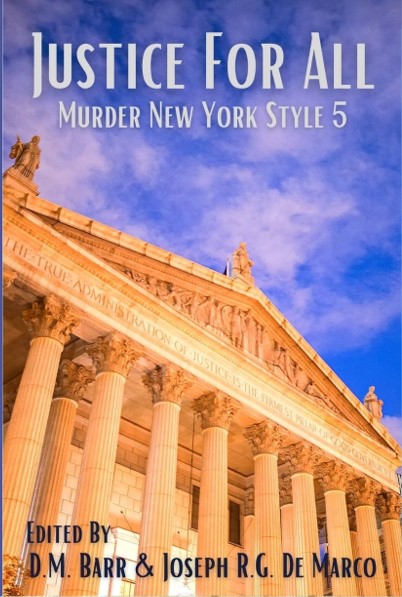Justice for All: Murder New York Style 5, recently released by Level Best Books. was conceived during a time of great political, social, and physical turmoil. The United States had just come out of its most contentious election in decades; a global pandemic threatened the lives of the world population just as the resulting recession affected their wallets; hate crimes were on a disturbing rise; and outraged citizens crowded city streets worldwide, decrying bias against race, immigration, and sexual orientation. The authors, all hailing from the New York/Tri-State Chapter of Sisters in Crime, say they found it hard not to be consumed by themes of justice when so much happening in the world was frustratingly beyond their control.
The ongoing battle for equality, integrity, and fairness reverberates in each of the anthology’s sixteen thought-provoking stories, their diversity covering the spectrum of mystery and suspense subgenres:
“Leading Ladies” by Lori Robbins is a traditional mystery with a humorous undercurrent that follows an octogenarian with a love of gambling and Broadway musicals who recruits her home stager granddaughter to investigate the entirely plausible albeit sudden death of her best friend.
“The Art of Payback” by Cathi Stoler is another traditional mystery, one in which a woman whose late mother was swindled out of a precious Picasso won’t rest until she exacts an artistic revenge on the art broker responsible.
“The New Guy” by Anne Marie Sutton describes a New York insurance company in the early seventies, where one of its veteran employees hasn’t yet embraced the civil rights movement, as shown by his reluctance to work alongside a minority intern.
“Harbor Life and City Silt” by Elle Hartford tackles the universal desire for co-existence in a futuristic tale of a city inhabited by both “landfolk” and “merfolk” where a string of murders threatens the peace.
“The Thanksgiving Ragamuffin” by Katherine Marple Kalb is historical fiction that describes an assault outside an opera singer’s Washington Square townhouse that raises the ongoing issue of antisemitism and anti-Irish bias.
“The Teacup” by Catherine Siemann is also set in the late nineteenth century and follows an immigrant woman living on the Lower East Side facing eviction and possible domestic abuse, who attracts the attention of one of the country’s few female attorneys.
“Injustice in Brooklyn” by Stephanie Wilson-Flaherty also focuses on immigration issues. Set in modern-day Bay Ridge, the story is narrated by a self-proclaimed busybody who helps a Latino family whose son has been accused of gun possession and attempted murder.
“Family Matters by Mary Jo Robertiello addresses LBGTQIA bias. In this story, a newly married gay minister with a gambling problem and a homophobic stepfather is suspected in the strangulation death of his mother.
“Windy Willows” by Nina Mansfield wrestles with financial abandonment and drug abuse through the tale of a desolate mom who’s lost her son to drugs and decides to secretly help another mother who’s been abandoned by her baby daddy.
“What Matters Most” by Nancy Good explores privilege as it follows a Manhattan mom who doesn’t fit in with the socialite crowd at her daughter’s private school, and how she reacts when she suspects another student’s mother of murder.
“When the Caged Bird Flies” by Catherine Maiorisi covers the trauma of a terror-stricken Black female victim who deals with the aftermath of rape by a white member of Congress in her own unique way.
“The World According to Lucy” by Susie Case puts sex trafficking front and center as a hardworking college student with a secret life collapses in class, prompting her professor to launch an investigation that includes the local tattoo parlor and her fellow classmates.
“Risky Assumptions” by Ellen Quint is the first of two stories in the anthology tackling ageism. At the older end of the spectrum, this is the tale of an older female attorney and her P.I. who investigate the murder of a modeling agency owner suspected of sexual abuse.
“Laundry After Midnight” by Nina Wachsman shows that ageism affects adolescents too as a twelve-year-old boy witnesses a murder through his apartment peephole and investigates on his own when the authorities and his parents chalk it up to an accident.
“David and the Garmento” by Roz Siegel also involves a boy on the brink of his teenage year, as his mother, the daughter of immigrants, plots to murder the husband who has not only abandoned her but plans to lure their son to his polygamous cult in India.
And finally, “A Tale for the Books” by D.M. Barr tackles literary justice in an ironic tale where a jury of publishers puts a blogger-slash-amateur book critic on trial for his arbitrary one-star reviews.
The satisfying endings of all sixteen tales mirror the chapter members’ universal feeling of hope in the world. Please read, enjoy, and if you have a moment, review.




